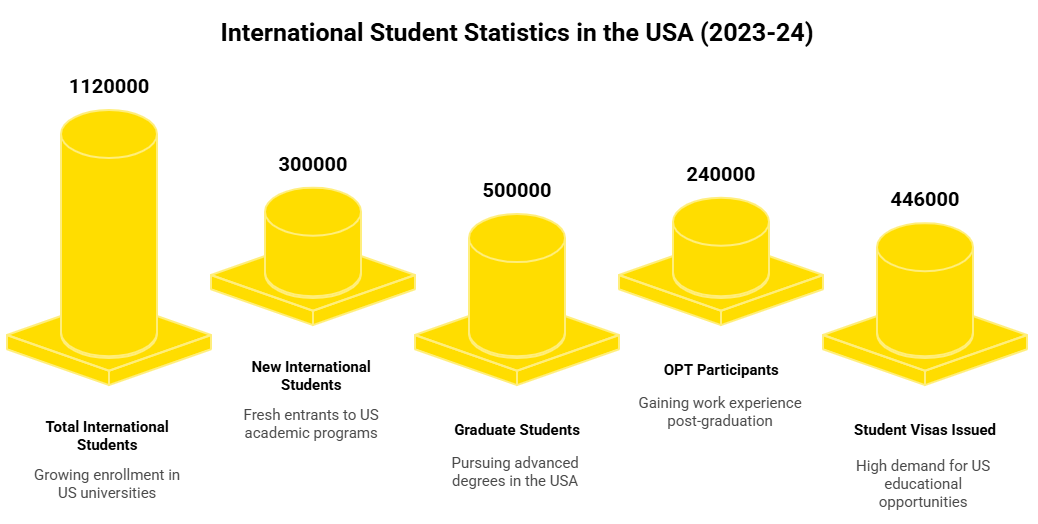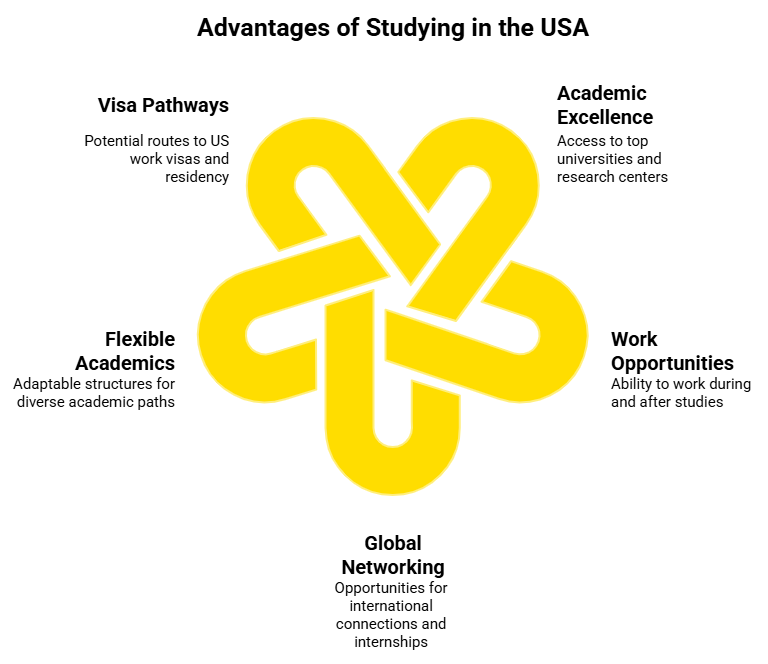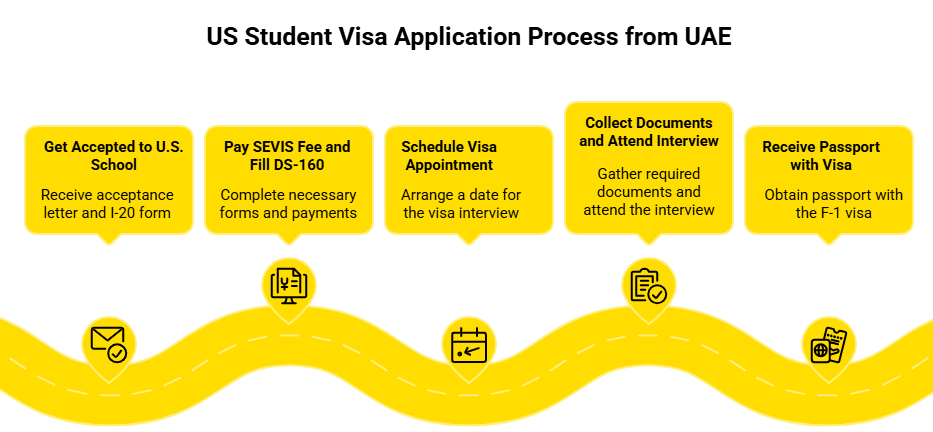Study in USA
Don't know what to do?
Get Free Counseling
Study in the USA – Complete Guide for UAE Students
The United States remains a popular choice for students from the UAE because of its well-regarded degrees, wide range of academic programs, and chances to work after graduation. With enrollment numbers going up and adaptable visa choices, it's a good place for both academic and career building.
- In 2023–24, over 1.12 million international students were studying in the USA, and this number keeps growing.
- Almost 300,000 new students started at US universities last year.
- More than 500,000 students are in graduate programs, which show a lot of interest in advanced degrees.
- Over 240,000 students got work experience through Optional Practical Training (OPT).
- More than 446,000 student visas were given out around the world, which shows a high level of international interest.

*Want guidance to apply for US Student Visa? Sign up with Y-Axis for comprehensive support with the process.
Why Study in the USA from the UAE?
For students from the UAE, studying in the USA means access to top-ranked universities, adaptable academic options, and a chance to experience a different culture. With over 4,000 schools and respected teachers, the U.S. education system helps students grow in creativity, research, and job skills.
- You can pick from many programs in science, tech, business, arts, and other fields.
- There are chances to work while studying and after graduation (CPT and OPT).
- You can gain from modern research centers and internships.
- The U.S. offers a varied cultural setting with support for international students.
- You can create global relationships and learn about international job options.
- The USA gives a solid education and a straightforward route to work or career plans after school, which makes it a popular spot for driven students from the UAE.
What is a US Student Visa?
A United States Student Visa, a non-immigrant visa, enables students from the UAE to pursue full-time education at approved US learning centers. The F-1 visa is the standard type, granted to those in academic or language programs. After a student is admitted to a SEVP-approved institution, they will get an I-20 form, which they need to apply for the visa.
The F-1 visa allows students to work part-time at their school and take part in CPT during their studies. They can also do OPT after completing their degree. Students must meet all enrollment and attendance standards during their program to keep their visa status.
Benefits of Studying in the USA for UAE Students
The benefits of studying in the USA are given below.
- Access to highly regarded universities and research centers.
- The ability to work while studying and after graduation via CPT and OPT programs.
- Access to a worldwide network of talent and internship possibilities.
- Adaptable academic structures that allow for double majors and course selection.
- Possible routes to an US H-1B work visa and permanent resident status.

Types of Study Programs in the USA
In the U.S., UAE students have access to academic programs fitting different aims and schedules. Options include bachelor's, master's, professional degrees, plus shorter courses and certificates. Students can customize their education to match their career and academic interests. U.S. schools offer respected, high-quality choices for degrees, specialized skills, or transfer programs, all supported by current teaching and global instructors.
Associate Degrees
In the U.S., an Associate Degree is a two-year program, often at community colleges. It gives students the option to either start working or move into a bachelor's degree program at a four-year school.
The two main types are:
- Associate of Arts (AA) and Associate of Science (AS): These degrees usually help students transfer to a university.
- Associate of Applied Science (AAS): This degree helps students get ready to work in specific technical or vocational jobs.
Many students from the UAE choose this path as it is a flexible and affordable way to pursue education in the U.S.
Undergraduate Degrees (Bachelor’s)
In the United States, a bachelor's degree usually takes four years to finish at a college or university. After finishing high school, many students choose this path to gain detailed knowledge in a specific major. Students also take general courses that help them improve how they think, communicate, and analyze.
There are different kinds of bachelor's degrees, like:
- Bachelor of Arts (BA): This degree focuses on subjects like humanities, social sciences, and arts.
- Bachelor of Science (BS): This degree focuses on fields like science, tech, and math.
- Bachelor of Business Administration (BBA): This degree focuses on business and management.
Students from the United Arab Emirates often pick bachelor's programs in the U.S. because they offer flexibility in their studies, chances to do internships, and good job opportunities after they graduate.
Graduate Degrees (Master’s)
In the United States, a master's degree is a postgraduate program that usually takes one to two years. It is for students who have finished their bachelor's degree and want to gain more knowledge in a specific area. These programs include advanced classes, research, and sometimes practical training.
Common types of master's degrees include:
- Master of Science (MS): Focuses on science, technology, engineering, and mathematics fields like engineering, IT, and data science.
- Master of Arts (MA): Covers subjects like humanities, education, and social sciences.
- Master of Business Administration (MBA): A popular choice for those seeking careers in management and leadership.
For students from the United Arab Emirates, a master's degree from the U.S. can provide academic recognition, practical learning experiences, and better career prospects worldwide.
Doctoral and Research Programs (PhD)
In the U.S., doctoral programs (PhDs) concentrate on unique research, in-depth analysis, and scholarly work. Completion usually takes three to six years, varying with the subject and research pace.
PhD candidates must:
- Finish upper-level classes in their field.
- Carry out their own research with guidance from professors.
- Produce and defend a dissertation that adds something new to their discipline.
Fields span science, engineering, medicine, business, law, and the humanities. For students from the UAE seeking careers in academia, research, or top-tier professions, a PhD from the U.S. offers worldwide recognition and good job opportunities in academic institutions, businesses, or governmental bodies.
Certificate and Non-Degree Programs
In the USA, certificate and non-degree programs are short academic or job-related courses at universities, community colleges, and specialized schools. Lasting from a few months to a year, they help people build skills, advance their careers, or try a new field without getting a full degree.
Common choices include:
- Job certificates in business, IT, healthcare, and marketing
- English courses for school or test prep
- Executive and continuing education
For students from the UAE, these programs are a manageable and cost-effective path to get U.S. educational experience, strengthen their resume, and become more employable, often without needing long visas or a full-time commitment.
Eligibility Criteria for US Student Visa
The eligibility criteria to apply for the USA Study Visa are given below.
- Official transcripts showing completion of secondary or undergraduate education.
- Proof of English language ability via IELTS, TOEFL, or Duolingo scores.
- SAT, ACT, GRE, or GMAT scores, if needed by the program.
- Bank statements that show sufficient funds for tuition and living costs.
- A valid passport and confirmation of plans to go back to the UAE after finishing your study.

US Student Visa Requirements for UAE Applicants
The documents required to apply for a US Student Visa are given below.
- Acceptance to a Student and Exchange Visitor Program (SEVP)-approved school and an I-20 form.
- Evidence they can afford tuition and living costs.
- Payment of the Student and Exchange Visitor Information System (SEVIS) fee and a completed online visa application (DS-160).
- A current passport, photos, and academic records.
- Attendance at a US visa interview.
US Student Visa Fees from the UAE
Detailed information about the fees for a US Student Visa is given below.
|
Fee Type |
Amount (USD) |
|
SEVIS I-901 Fee |
$350 |
|
DS-160 Visa Application |
$185 |
|
Visa Issuance Fee |
Varies |
|
Biometric Services |
Included in visa process |
|
Optional Expedited Booking |
Varies |
US Student Visa Processing Time for UAE Residents
Detailed information about the processing times for US Student Visa is given below.
|
Process Stage |
Estimated Timeframe |
|
Visa Appointment Availability |
1–4 weeks |
|
Interview to Decision Time |
3–10 working days |
|
Passport Return & Visa Stamping |
3–7 working days |
|
Recommended Application Start |
3–5 months before course start |
How to Apply for a US Student Visa from the UAE?
The process to apply for US Student Visa from the UAE is given below.
Step 1: Get accepted to a U.S. school and obtain an I-20 form.
Step 2: Pay the SEVIS I-901 fee and fill out the DS-160 form.
Step 3: Schedule a visa appointment and pay the application fee.
Step 4: Collect the required documents and go to your embassy interview.
Step 5: Get your passport back with the F-1 visa.

Working While Studying in the USA
International students from the UAE with F-1 visas can work in the U.S. if they follow immigration rules. While classes are in session, they can work up to 20 hours a week in approved on-campus jobs, like in libraries or cafeterias. These jobs don't need extra work approval and give students useful experience. During school breaks, students can work full-time on campus.
Students can also get permission to work off campus through programs like Curricular Practical Training (CPT) and Optional Practical Training (OPT). CPT lets students work part-time or full-time in their field of study while they're still in school. OPT allows graduates to work in a job related to their degree for up to 12 months, or 24 months for STEM graduates. The Designated School Official (DSO) must approve all work, whether it's on or off campus, to keep the student's visa valid.
*Looking for assistance to apply for US Work Visa? Let Y-Axis assist you with the process.
OPT, CPT, and Pathway to H-1B Visa
For students with F-1 visas in the U.S., Curricular Practical Training (CPT) and Optional Practical Training (OPT) are important work options. CPT lets students get jobs off campus that are related to what they are studying while they are still in school. Usually, this is a paid internship or co-op program, and the university's Designated School Official (DSO) has to approve it. Depending on the course and school rules, CPT can be either full-time or part-time.
OPT gives students a chance to work in the U.S. for up to a year after they graduate. Students in STEM fields can get a 24-month extension. OPT has to be related to the student's major and needs approval from U.S. Citizenship and Immigration Services (USCIS). Many international students who are on OPT find jobs with U.S. companies that will sponsor them and apply for an H-1B visa, which is a work visa for skilled workers. If the student finds the right employer and the timing is right, OPT can be a good way to start a long-term career and maybe even live in the U.S. permanently.
Scholarships for UAE Students in the USA
|
Scholarship Name |
Amount |
What It Covers |
|
Fulbright Foreign Student Program |
Fully funded |
Tuition, living expenses, health insurance, airfare, and other academic costs |
|
AAUW International Fellowships |
$18,000 – $30,000 |
Tuition and living expenses for female graduate students from outside the U.S. |
|
Stanford Knight-Hennessy Scholars |
Full tuition + stipend |
Full tuition, living expenses, academic enrichment, and leadership training |
|
Yale Young Global Scholars Program |
Partial to full funding |
Program tuition support for high-achieving high school students |
|
Illinois Wesleyan University Scholarships |
Up to $30,000/year |
Merit-based tuition reduction for undergraduate international students |
|
Harvard University Financial Aid |
Up to full need-based support |
Tuition, housing, and living expenses based on demonstrated financial need |
|
Clark University Global Scholars Program |
$15,000 – $25,000/year |
Merit scholarships for undergraduate students with strong academic performance |
|
Aga Khan Foundation International Scholarship |
Based on need |
Tuition and living expenses for postgraduate studies (50% grant, 50% loan) |
|
Emirates Foundation Scholarships |
Varies |
Funding support for Emirati students pursuing higher education abroad |
|
Amideast EducationUSA Scholarships |
Partial funding |
Assistance with university prep and partial scholarships for high-achieving students |
Top Universities in the USA for UAE Students
|
QS World Rank 2025 |
University Name |
Location |
Popular Courses for International Students |
|
1 |
Massachusetts Institute of Technology (MIT) |
Cambridge, MA |
Engineering, Computer Science, Artificial Intelligence |
|
3 |
Stanford University |
Stanford, CA |
Business, Computer Science, Mechanical Engineering |
|
4 |
Harvard University |
Cambridge, MA |
Law, Economics, Medicine, Public Policy |
|
10 |
University of Chicago |
Chicago, IL |
Economics, Statistics, Political Science |
|
11 |
University of Pennsylvania |
Philadelphia, PA |
Business (Wharton), Finance, Data Science |
|
13 |
California Institute of Technology (Caltech) |
Pasadena, CA |
Physics, Chemistry, Aerospace Engineering |
|
16 |
Yale University |
New Haven, CT |
Law, International Relations, Humanities |
|
18 |
Columbia University |
New York, NY |
Journalism, Finance, Urban Studies |
|
20 |
Princeton University |
Princeton, NJ |
Mathematics, Philosophy, Public Policy |
|
22 |
Cornell University |
Ithaca, NY |
Architecture, Engineering, Hospitality Management |
US Intakes for International Students
International students can apply for any of the three intakes to study in the US:
- Fall (August/September): This is the main entry point, with the most programs available.
- Spring (January): This is the second largest entry point, with a decent number of course choices.
- Summer (May/June): This entry point is less common and mostly for short courses or language programs.
Students from the UAE should apply 6–8 months before their intended start date.
Cost of Studying in the USA for UAE Students
Detailed information about the cost of studying in the US is given below.
|
Expense Category |
Estimated Cost (USD/Year) |
Details |
|
Tuition (Undergraduate) |
$20,000 – $40,000 |
Varies by institution type and program of study |
|
Tuition (Graduate) |
$25,000 – $50,000 |
Higher for programs like MBA, engineering, and medicine |
|
Living Expenses |
$12,000 – $20,000 |
Includes housing, food, transportation, and utilities |
|
Health Insurance |
$800 – $1,500 |
Mandatory for all international students |
|
Books & Supplies |
$1,000 – $2,000 |
Course materials, software, lab equipment |
|
Personal Expenses |
$1,500 – $3,000 |
Clothing, recreation, mobile, internet, and other personal items |
|
Airfare (Round Trip) |
$800 – $1,200 |
Annual travel between UAE and the USA |
Tips for a Successful US Student Visa Application
- Submit your application early and make sure all your paperwork is complete.
- Prove you have close ties to your home country and that you plan to study.
- Practice answering common visa interview questions so you feel ready.
- Provide financial documents that are easy to understand and check.
- Make sure your SEVIS and DS-160 records are correct and match each other.
How Can Y-Axis Help You
Y-Axis aids UAE students who want to study in the USA with complete support. We make the process easier at each step, from selecting a program to visa approval.
Our services include:
- Matching courses and universities to students.
- Coaching for tests like the SAT, GRE, and IELTS.
- Helping with visa paperwork and interviews.
- Applying for scholarships.
- Giving advice on OPT/CPT and career support after arrival.
Looking for inspiration
Explore what Global Citizens have to say about Y-Axis in shaping their future
Frequently Asked Questions
